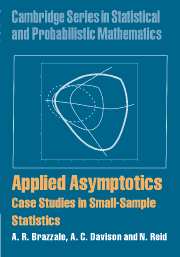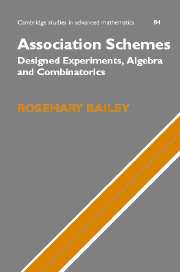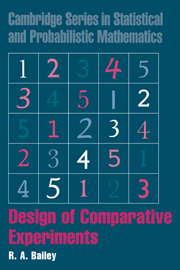Refine search
Actions for selected content:
2348 results in Statistical theory and methods
20 - On Types of Scientific Inquiry: The Role of Qualitative Reasoning
-
- Book:
- Statistical Models and Causal Inference
- Published online:
- 05 June 2012
- Print publication:
- 23 November 2009, pp 337-356
-
- Chapter
- Export citation
15 - On Specifying Graphical Models for Causation, and the Identification Problem
-
- Book:
- Statistical Models and Causal Inference
- Published online:
- 05 June 2012
- Print publication:
- 23 November 2009, pp 255-278
-
- Chapter
- Export citation
19 - Diagnostics Cannot Have Much Power Against General Alternatives
-
- Book:
- Statistical Models and Causal Inference
- Published online:
- 05 June 2012
- Print publication:
- 23 November 2009, pp 323-334
-
- Chapter
- Export citation

Applied Asymptotics
- Case Studies in Small-Sample Statistics
-
- Published online:
- 19 November 2009
- Print publication:
- 31 May 2007

Association Schemes
- Designed Experiments, Algebra and Combinatorics
-
- Published online:
- 16 November 2009
- Print publication:
- 26 February 2004
5 - Stochastic Processes: An Overview
-
- Book:
- From Finite Sample to Asymptotic Methods in Statistics
- Published online:
- 05 June 2012
- Print publication:
- 30 October 2009, pp 100-118
-
- Chapter
- Export citation
10 - Regression Models
-
- Book:
- From Finite Sample to Asymptotic Methods in Statistics
- Published online:
- 05 June 2012
- Print publication:
- 30 October 2009, pp 293-337
-
- Chapter
- Export citation
7 - Asymptotic Distributions
-
- Book:
- From Finite Sample to Asymptotic Methods in Statistics
- Published online:
- 05 June 2012
- Print publication:
- 30 October 2009, pp 173-239
-
- Chapter
- Export citation
Bibliography
-
- Book:
- From Finite Sample to Asymptotic Methods in Statistics
- Published online:
- 05 June 2012
- Print publication:
- 30 October 2009, pp 375-380
-
- Chapter
- Export citation
Preface
-
- Book:
- From Finite Sample to Asymptotic Methods in Statistics
- Published online:
- 05 June 2012
- Print publication:
- 30 October 2009, pp xi-xii
-
- Chapter
- Export citation
4 - Elements of Statistical Decision Theory
-
- Book:
- From Finite Sample to Asymptotic Methods in Statistics
- Published online:
- 05 June 2012
- Print publication:
- 30 October 2009, pp 83-99
-
- Chapter
- Export citation
9 - Categorical Data Models
-
- Book:
- From Finite Sample to Asymptotic Methods in Statistics
- Published online:
- 05 June 2012
- Print publication:
- 30 October 2009, pp 273-292
-
- Chapter
- Export citation

Design of Comparative Experiments
-
- Published online:
- 30 October 2009
- Print publication:
- 17 April 2008
Frontmatter
-
- Book:
- From Finite Sample to Asymptotic Methods in Statistics
- Published online:
- 05 June 2012
- Print publication:
- 30 October 2009, pp i-vi
-
- Chapter
- Export citation
11 - Weak Convergence and Gaussian Processes
-
- Book:
- From Finite Sample to Asymptotic Methods in Statistics
- Published online:
- 05 June 2012
- Print publication:
- 30 October 2009, pp 338-374
-
- Chapter
- Export citation
Contents
-
- Book:
- From Finite Sample to Asymptotic Methods in Statistics
- Published online:
- 05 June 2012
- Print publication:
- 30 October 2009, pp vii-x
-
- Chapter
- Export citation
3 - Hypothesis Testing
-
- Book:
- From Finite Sample to Asymptotic Methods in Statistics
- Published online:
- 05 June 2012
- Print publication:
- 30 October 2009, pp 68-82
-
- Chapter
- Export citation
6 - Stochastic Convergence and Probability Inequalities
-
- Book:
- From Finite Sample to Asymptotic Methods in Statistics
- Published online:
- 05 June 2012
- Print publication:
- 30 October 2009, pp 119-172
-
- Chapter
- Export citation
2 - Estimation Theory
-
- Book:
- From Finite Sample to Asymptotic Methods in Statistics
- Published online:
- 05 June 2012
- Print publication:
- 30 October 2009, pp 42-67
-
- Chapter
- Export citation
1 - Motivation and Basic Tools
-
- Book:
- From Finite Sample to Asymptotic Methods in Statistics
- Published online:
- 05 June 2012
- Print publication:
- 30 October 2009, pp 1-41
-
- Chapter
- Export citation
